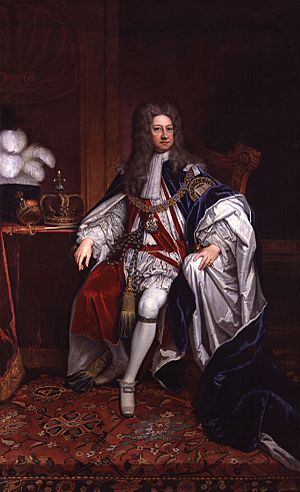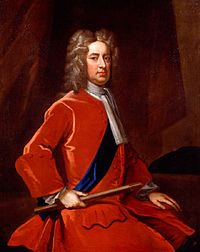Sarah Churchill, Duchess of Marlborough facts for kids
Quick facts for kids
The Duchess of Marlborough
|
|
|---|---|
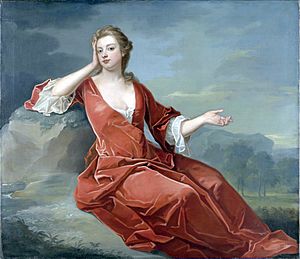
Sarah Churchill, Duchess of Marlborough, by Charles Jervas, after 1714
|
|
| Keeper of the Privy Purse | |
| In office 1702–1711 |
|
| Monarch | Anne |
| Preceded by | Caspar Henning |
| Succeeded by | The Lady Masham |
| Personal details | |
| Born |
Sarah Jenyns
5 June 1660 St Albans, Hertfordshire, Kingdom of England |
| Died | 18 October 1744 (aged 84) St James's, London, Kingdom of Great Britain |
| Spouses | John Churchill, 1st Duke of Marlborough (m. 1677/78; d. 1722) |
| Children | 7, including:
|
| Parents | Richard Jennings Frances Thornhurst |
| Signature | |
Sarah Churchill, Duchess of Marlborough (born Sarah Jenyns, June 5, 1660 – October 18, 1744), was a very important English noblewoman. She became one of the most powerful women of her time. This was thanks to her close friendship with Anne, Queen of Great Britain. People knew about Sarah's influence on Princess Anne. Important leaders often tried to get Sarah's help to gain favor with Anne.
When Anne became queen, Sarah knew a lot about how the government worked. Her close bond with the queen made her a strong ally and a tough opponent. Sarah had a "long and loving" marriage of over 40 years with her husband, the famous general John Churchill, 1st Duke of Marlborough.
After Anne's father, King James II, lost his throne, Sarah helped Anne. She worked to protect Anne's interests during the reigns of William III and Mary II. When Anne became queen in 1702, the Duke of Marlborough and Sidney Godolphin, 1st Earl of Godolphin became leaders of the government. This was partly because of Sarah's influence.
While the Duke fought in the War of the Spanish Succession, Sarah kept him updated on court events. She also shared his requests and political advice with the queen. Sarah worked hard for the Whig party. She also spent time on building projects, like Blenheim Palace. Sarah was a strong-willed woman. She often argued with the Queen when they disagreed on politics or appointments. After their final disagreement in 1711, Sarah and her husband were sent away from court. However, she got her revenge under the Hanoverian kings after Anne's death.
Later, she had famous disagreements with many important people. These included her daughter Henrietta Godolphin, 2nd Duchess of Marlborough, the architect John Vanbrugh, Prime Minister Robert Walpole, King George II, and Queen Caroline. The money she inherited made her one of the richest women in Europe. She died in 1744, at 84 years old.
Contents
Sarah's Early Life
Sarah Jennings was born on June 5, 1660. She was likely born at Holywell House, Hertfordshire in St Albans, Hertfordshire. Her father was Richard Jennings, a member of Parliament. Her mother was Frances Thornhurst.
In 1673, Sarah joined the royal court. She became a maid of honor to James’s second wife, Mary of Modena. Around 1675, Sarah became very close to the young Princess Anne. Their friendship grew stronger as they got older. In late 1675, when Sarah was only 15, she met John Churchill. He was 10 years older and fell in love with her.
Sarah's Marriage
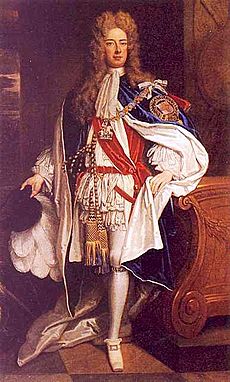
In 1677, Sarah's brother Ralph died. Sarah and her sister Frances inherited their family's estates. John Churchill chose Sarah over another wealthy woman. However, both their families did not approve of their marriage. So, they married secretly in the winter of 1677–78.
John and Sarah were Protestants in a mostly Catholic court. This made their political loyalties tricky. Their marriage was kept secret from most people. This allowed Sarah to keep her job as Maid of Honor. When Sarah became pregnant, their marriage was announced publicly. She left court to have her first child, Harriet, who died as a baby.
When the Duke of York (future King James II) went into exile, John and Sarah went with him. King Charles II rewarded John's loyalty by making him Baron Churchill. Sarah then became Lady Churchill. Sarah was later appointed a Lady of the Bedchamber to Princess Anne in 1683.
Life During King James II's Reign
King James II was Catholic, which caused problems in Protestant England. When his wife had a Catholic son in 1688, people worried. A group of politicians invited Prince William of Orange to invade England. William was married to James's Protestant daughter, Mary.
King James ordered Lady Churchill and Princess Anne to be kept at Anne's home. Both their husbands had switched their support to William. Sarah wrote that she and Anne easily escaped. They fled to Nottingham. Sarah likely wanted to protect herself and her husband. If James had won, they could have been in serious trouble. But James fled to France, and William took the throne.
Challenges with William III and Mary II
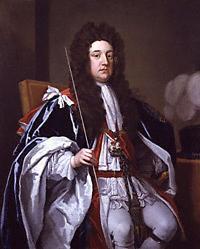
Life was hard for Sarah during the reign of William and Mary. Sarah and John had less favor than before. The new queen, Mary II, wanted Anne to fire Sarah. But Anne refused. This caused a lasting rift between Mary and Anne.
In 1689, Anne's supporters wanted her to get £50,000 a year from Parliament. This would make her less dependent on William and Mary. Sarah was seen as the main person pushing for this. William offered the money from his own funds, but Anne refused. She wanted a parliamentary grant, which was more secure. Anne eventually got the money, and she felt she owed it to Sarah.
Sarah's success made Queen Mary dislike her even more. Mary could not fire Sarah, so she kicked Sarah out of her court lodgings. Anne left court too, and they stayed with friends. Anne kept refusing to dismiss Sarah. Even when a document supporting James II was found, Anne stood by Sarah. John Churchill was even put in the Tower of London. Sarah and Anne grew closer during this difficult time.
After Mary II died in 1694, William III gave Anne her honors back. He also restored John Churchill to his positions. However, William feared Sarah's strong influence. He kept Anne out of government affairs.
Sarah's Power as Queen Anne's Friend
In 1702, William III died, and Anne became queen. Anne immediately offered John Churchill a dukedom. Sarah first said no because she worried about the cost. A duke's family was expected to spend a lot of money. Anne then offered them £5,000 a year for life from Parliament. She also gave them an extra £2,000 a year from her own funds. They accepted the dukedom.
Sarah was given important roles at court. She became Mistress of the Robes (the highest job for a woman at court) and Keeper of the Privy Purse. John became Captain-General of the army.
While the Duke of Marlborough was fighting in the war, Sarah stayed in England. She was the most powerful woman in England, besides the queen. She often oversaw the building of Blenheim Palace, a gift from Queen Anne. Anne sent Sarah news and asked for her advice on most matters.
Sarah was known for telling the queen exactly what she thought. She did not flatter Anne. Anne and Sarah used nicknames for each other: Mrs Freeman (Sarah) and Mrs Morley (Anne). Sarah managed many of the queen's affairs, from her money to who could see her.
Sarah's Influence Changes
Anne expected kindness from her closest friend. But Sarah was often bossy and controlling. They had a big political disagreement when Sarah insisted that her son-in-law, Charles Spencer, 3rd Earl of Sunderland, join the Privy Council. Sarah supported the Whigs, who backed the Duke of Marlborough in the war. The Whigs hoped to use Sarah's influence.
Anne did not want to appoint Sunderland. She disliked the radical Whigs. Sarah used her friendship with Sidney Godolphin, 1st Earl of Godolphin to get these appointments. But she kept pushing Anne herself. She sent Anne Whig reading materials. In 1704, Anne told Lord Godolphin that she did not think she and Sarah could be true friends again.
Personality Clashes
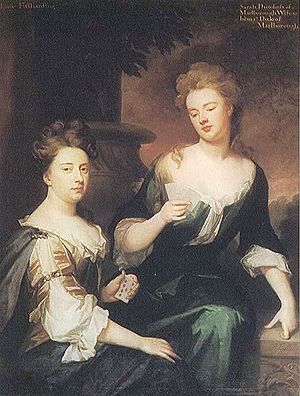
Sarah's honesty and disregard for rank, which Anne once admired, now seemed rude. Sarah had close ties with the two most powerful men: Marlborough and Godolphin. Godolphin, though Sarah's friend, found her bossy and interfering.
Sarah, a woman in a man's political world, always gave advice. She expressed her strong opinions and insisted on being heard. Yet, she was charming and lively. Many people enjoyed her wit.
Anne's affection for Sarah seemed to fade for several reasons. Anne was frustrated by Sarah's long absences from court. Sarah rarely visited, despite Anne's many letters. There was also a political difference. Anne was a Tory, and Sarah was a Whig.
Sarah did not share Anne's strong interest in religion. She wanted Anne to support the Whigs more, but Anne was not ready to do so.
In 1703, Sarah's only surviving son, John Churchill, Marquess of Blandford, died from smallpox. Sarah was heartbroken and became withdrawn. She closed herself off from Anne and was cold in her letters. However, Sarah did not let Anne grieve alone when Anne suffered a loss.
After Anne's husband, Prince George of Denmark, died in 1708, Sarah arrived uninvited. She found Anne with the prince's body. Sarah pushed the heartbroken queen to move palaces. Anne refused. Sarah then scolded Anne for grieving too much. Sarah's lack of sensitivity deeply offended Anne. This added to the growing strain on their friendship.
Sarah's Fall From Favor
Abigail Masham: A New Rival
Sarah had helped her poor cousin, Abigail Hill, get a job at court. Abigail was working as a servant when Sarah found her. Sarah helped Abigail out of kindness. Abigail became a Lady of the Bedchamber to Queen Anne in 1704.
Abigail was also a cousin to the Tory leader Robert Harley, 1st Earl of Oxford and Mortimer. Abigail was flattering, quiet, and shy. She was the opposite of Sarah, who was strong, direct, and critical. During Sarah’s frequent absences, Abigail and Anne grew close. Abigail gave the queen the kindness Anne wanted from Sarah. She also never pressured the queen about politics. Anne loved Abigail's flattery.
Sarah did not know about Anne and Abigail's growing friendship. She was surprised when she found out Abigail often saw the queen in private. Sarah learned about Abigail's secret wedding in 1707, months after it happened. Anne had been present and had given Abigail £2,000 from her own funds. Sarah, as Keeper of the Privy Purse, had known nothing about this payment. This showed Sarah that Anne had been dishonest.
A Strained Relationship
In July 1708, the Duke of Marlborough won a big victory. On the way to a church service, Sarah argued fiercely with Anne about the jewels Anne wore. Sarah also showed Anne a letter from the Duke. It suggested the queen should use the victory for political gain. This implied Anne should publicly support the Whigs, which offended her. At the service, Sarah told the queen to "be quiet" when Anne continued the argument. This offended the queen even more.
Anne's next letter to Sarah was very cold. Sarah, who rarely admitted fault, realized she had gone too far. She apologized, but it had little effect. Anne wrote to Marlborough, asking him to keep their rift private. But he could not stop his wife's actions.
Sarah kept pushing Anne to support the Whigs. Anne, already unwell, felt used and harassed. She found comfort in Abigail Masham. Anne had explained that she did not want the public to know about her failing friendship with Sarah. This was because it would hurt the Duke of Marlborough's authority. Sarah kept her jobs for her husband's sake. The tension between the two women lasted until early 1711. This year marked the end of their friendship.
Sarah had always been jealous of Anne's affection for Abigail. She and the Whig party tried to force Anne to dismiss Abigail. All these attempts failed. Anne even cried to politicians, begging them to oppose the idea. People thought the Marlboroughs looked foolish for making such a big deal out of a small matter.
Anne's strong support for Abigail angered Sarah. Sarah even hinted that Anne and Abigail were in a romantic relationship. During the mourning period for Anne's husband, Sarah was the only one who did not wear proper mourning clothes. This made it seem like she did not think Anne's grief was real. Eventually, Anne decided she no longer needed the Duke of Marlborough. She dismissed him on charges of misusing funds.
Final Dismissal
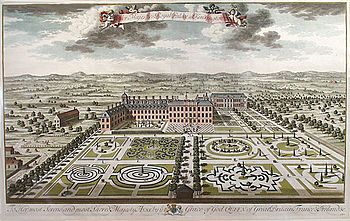
Sarah's last attempt to fix her friendship with Anne was in 1710. Sarah asked why their friendship had ended. Anne was cold, repeating phrases like "I shall make no answer" and "you may put it in writing."
Sarah was so upset that she cried. She even threatened Anne with God's judgment. Anne replied that God's judgment on her was her own business. But she later said this was the one remark from Sarah that deeply hurt her.
The Duke of Marlborough realized Anne would dismiss them. He asked her to keep them in their jobs for nine more months. But Anne told Marlborough that Sarah had to resign immediately. Sarah was to return her gold key, a symbol of her authority, within two days. Years of testing the queen's patience finally led to her dismissal. Sarah, in a fit of pride, told Marlborough to return the key right away.
In January 1711, Sarah lost her court jobs. Abigail Masham took over as Keeper of the Privy Purse. The Marlboroughs also lost government funding for Blenheim Palace. Building stopped for the first time since 1705. Now out of favor, they left England and traveled in Europe. The Duke was popular in Germany, and they were welcomed with honors.
Sarah did not like being away from England. She complained that they were honored abroad but disgraced at home. She found life at royal courts boring. She took healing waters in Germany and kept up with English politics through letters.
Return to Favor
Sarah and Queen Anne never made up. Queen Anne died on August 1, 1714. The Marlboroughs returned to England that afternoon. The Act of Settlement 1701 ensured a Protestant king. Georg Ludwig, Elector of Hanover, became King George I of Great Britain.
The new king was supported by the Whigs. George I formed a Whig government. He was friends with the Marlboroughs. The Duke of Marlborough had fought with him in the war. George's first words to Marlborough as king were, "My lord Duke, I hope your troubles are now over." Marlborough got his old job back as Captain-General of the Army.
Sarah was happy to be back in England. The Duke became one of the king's close advisers. Sarah moved back into Marlborough House. She tried to find good husbands for her granddaughters. Her eldest granddaughter, Henrietta, married Thomas Pelham-Holles in 1717. All of Sarah's grandchildren made good marriages.
In 1716, her husband had two strokes. The second one left him unable to speak. Sarah spent a lot of time with him. He recovered shortly after. Even after he recovered, Sarah read his letters. She wanted to prevent another stroke.
Sarah had a good relationship with her daughter Anne Spencer. She was heartbroken when Anne died in 1716. Sarah kept Anne's favorite cup and a lock of her hair. She adopted Anne's youngest child, Lady Diana, who became her favorite granddaughter.
Sarah's Later Years

John Churchill died in 1722. Sarah arranged a large funeral for him. Their daughter, Henrietta, became duchess. Sarah became a trustee of the Marlborough estate. She used her business skills to manage the family's money.
Sarah's personal income was now huge. She invested in land, believing it would protect her money. She bought Wimbledon manor in 1723 and rebuilt the house. Her wealth was so great that she hoped to marry her granddaughter, Lady Diana Spencer, to Frederick, Prince of Wales. She offered a huge dowry of £100,000.
However, Robert Walpole, the Prime Minister, stopped the plan. Walpole, though a Whig, had angered Sarah. He supported peace in Europe, and she did not trust his finances. Despite this, Sarah kept good relations with the royal family. Queen Caroline sometimes invited her to court.
The Duchess of Marlborough was a very capable business manager. This was unusual for women at that time. Her friend Arthur Maynwaring wrote that she was better at business than any man. She never truly liked Blenheim Palace, calling it "that great heap of stones." But she became more involved in its building. She wrote about the new waterworks, saying, "I believe it will be beautiful."
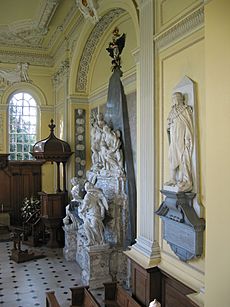
The Duchess fought against anything she thought was too fancy. She reduced the stables to one-third of their planned size. She allowed only two grand features: the Marlboroughs' tomb and the Column of Victory in the park. The column was 130 feet tall. The Duchess carefully watched all the building at Blenheim. She argued with anyone who did not follow her wishes.
Her detailed checks also extended to her smaller land purchases. She kept careful records of her money. She also watched for any dishonesty from her agents.
Her friendship with Queen Caroline ended. Sarah refused the queen access through her Wimbledon estate. This made her lose her £500 income as Ranger of Windsor Great Park. Sarah was also rude to King George II. She said he was "too much of a German." This further distanced her from the court.
Sarah never lost her good looks. Despite her declining popularity, she received many marriage offers after her husband's death. She chose not to remarry, preferring her independence. Sarah continued to argue against court decisions. These decisions said that the Marlboroughs should pay for Blenheim Palace themselves, not the government. This made her unpopular. As a trustee of her family's estate, she could easily have paid.
She was surprised by the grief she felt when her eldest daughter died in 1733. Sarah lived to see her enemy Robert Walpole fall in 1742. She died at 84, on October 18, 1744, at Marlborough House. She was buried at Blenheim Palace. Her husband's body was moved from Westminster Abbey to be buried beside her.
Sarah's Legacy
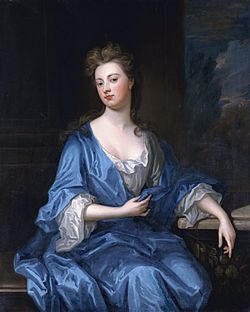
Sarah Churchill's downfall was mostly due to her own difficult relationship with Queen Anne. However, she was a lively and smart woman. She helped Anne's interests when Anne was a princess. But Sarah found Anne a boring talker and did not enjoy her company.
Sarah believed she had the right to force her political advice on Anne. She got angry if Anne refused to take it. Sarah seemed to underestimate Anne's strong character. She kept thinking she could control a woman whom foreign ambassadors described as "very determined." Besides her famous bad temper, Sarah's main weakness was her inability to accept anyone else's point of view.
Abigail Masham also played a key role in Sarah’s fall. Abigail was modest and quiet. She promoted the Tory policies of her cousin Robert Harley, 1st Earl of Oxford. Sarah had helped Abigail get her court job. But Sarah soon saw Abigail as an enemy who took her place in Anne’s affections. This happened as Sarah spent more time away from the Queen.
During her life, Sarah wrote 26 wills. She bought 27 estates. She had over £4 million in land and a large income. She left money to rising Whig politicians like William Pitt, 1st Earl of Chatham. She left little to the poor. But she gave her servants large amounts of money. Her favorite servant received £16,000, which is like £1.32 million today.
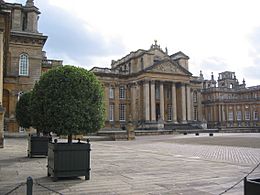
Most of Sarah's money went to her grandson, John Spencer. He inherited her many estates, including Wimbledon Park. Marlborough House was empty for 14 years after her death. It later became a royal residence. Today, it is the Commonwealth Secretariat. Much of St Albans is named after the Marlboroughs because of Sarah's influence.
Sarah died "immensely rich." She was not greatly missed by her family or the public. But her efforts to continue the Marlborough family's legacy were important. Because of her influence, Sarah arranged marriages for her family members into England’s most important noble families.
Sarah's Children
The Duke and Duchess of Marlborough's children who lived past childhood married into very important families in Great Britain:
| Image | Name | Birth date | Death date | Brief biography |
|---|---|---|---|---|
| Harriet Churchill | October 1679 | October 1679 | Died as a baby. | |
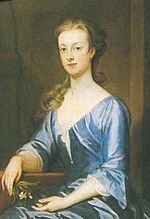 |
Henrietta Churchill (later Godolphin), 2nd Duchess of Marlborough | 19 July 1681 | 24 October 1733 | Married Francis Godolphin in 1698. Their son, William, died in 1731. Their daughter Henrietta married Thomas Pelham-Holles. Their daughter Mary married Thomas Osborne. |
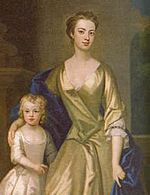 |
Anne Churchill (later Spencer) | 27 February 1683 | 15 April 1716 | Anne married Charles Spencer in 1699. After her sister Henrietta died, their son, Charles, became the 3rd Duke of Marlborough. Charles is an ancestor of Winston Churchill. Their son John is an ancestor of the Earls Spencer and Diana, Princess of Wales. Their daughter Diana almost married Frederick, Prince of Wales. |
 |
John Churchill, Marquess of Blandford | 13 February 1686 | 20 February 1703 | John was the heir to the Dukedom of Marlborough. He died unmarried and without children in 1703. So, the dukedom passed to Henrietta after his father's death. |
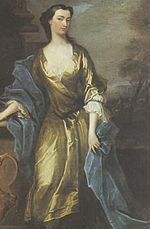 |
Elizabeth Churchill (later Egerton) | 15 March 1687 | 22 March 1714 | Married Scroop Egerton in 1703. They had children. |
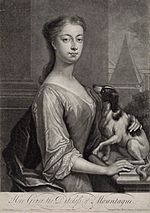 |
Mary Churchill (later Montagu) | 15 July 1689 | 14 May 1751 | Married John Montagu in 1705. They had children. |
| Charles Churchill | 19 August 1690 | 22 May 1692 | Died as a baby. |
See also
 In Spanish: Sarah Churchill para niños
In Spanish: Sarah Churchill para niños




